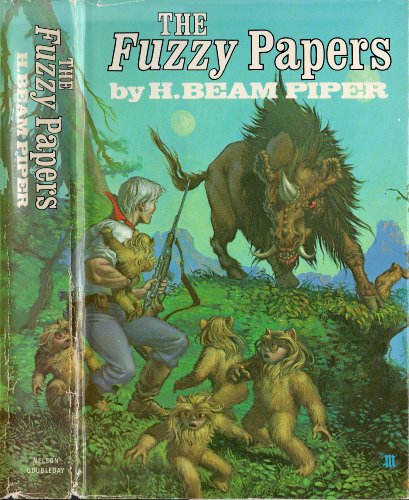
There are entire libraries filled with books I haven't read, even if you count only science fiction books that were published before 1972, the year I arrived in the USA and actively started reading that genre. One of these books that I hadn't read, until a few days ago, was H. Beam Piper's "Fuzzy Papers," which is actually a compilation of "Little Fuzzy" (1962) and "Fuzzy Sapiens" (1964) that was published in 1980.
Piper's style is light and easy to read. The dialog is only slightly odd, in the sense that a lot of dialog composed in early 20th C. prose is slightly odd: stilted, as if the speaker had swallowed a dictionary spiced with a little thesaurus. Another feature of early 20th C. science fiction is that Piper relieves himself of several info dumps, lengthy passages where he finds it necessary to explain things that he believes are essential to the story.
The story itself concerns a central question to science fiction: what is a person? When a prospector stumbles across friendly natives on another planet, he finds himself thrust into the position of having to defend them against exploitation. The theme is actually quite common for science fiction published in the sixties and seventies. Other writers of that time who used it extensively include Andre Norton and Alan Dean Foster.
Piper trots out some of the naive notions of what people assumed made persons into thinking beings. He uses them to describe the Fuzzies - two-foot tall furry humanoid beings with the personalities of kittens - as thinking beings. This is one of the places where he indulges in his info dumps.
The characters in Piper's story are, for the most part, charmed by the Fuzzies, and want to protect them. This is where the story becomes less than charming. I had to look up the history of the Indian adoption programs, and of the Australian experiment in aborigine placement.
Americans had a long history of removing children from Indian tribes and placing them with Whites. There were various rationales, but the one used for the Indian Adoption Project was that placement would speed a child's assimilation into White culture. Indian rights activists called this akin to genocide, but not until the Indian Child Welfare Act of 1978 (well after publication of these stories) was the practice stopped by force of law.
The Australian program was perhaps harsher, even involving abduction of children by state agents, with the aim to eradicate the Aboriginal culture by intermarriage and acculturation. It ended in the 1960s, and in recent years the Australian government has been making halfhearted attempts to re-connect families with their so-called "Stolen Generation." (Some documentation, notably a resolution passed by the Navajo Tribal Council in 1968, makes me suspect that abductions were also used in the USA, but at least here they weren't actually legal, even if they weren't investigated with a great deal of vigor.)
While looking up this information, I also found a reference of a similar decades long program in Switzerland that spanned WW II and ended in 1973, that involved stealing children from Roma families. (Ironic when you consider that the Rom were popularly rumored to steal children.)
So it isn't too surprising to find Piper speaking nonchalantly about placing Fuzzies with humans, who would then become their guardians. Even if the idea seems untenable today, at the time he was writing it seems to have been a generally accepted practice with which few people (that Piper was likely to have heard from) found issue.
With the exception of this callous, though entirely unsurprising attitude for the times, the book was fun to read. Give it a try, especially if you enjoy Heinlein's early style, of which Piper's story is quite reminiscent.

1 Comments:
Didn't notice the bad social experimenting when I read these some decades ago. I do remember how absolutely delightful I found the Fuzzies, and their interactions w/ their human guardians.
Post a Comment
<< Home